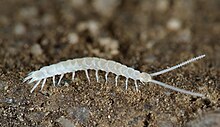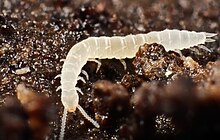
Back مؤتلفات (طائفة) Arabic مؤتلفات ARZ Simfillər Azerbaijani سیمفیللر AZB Сімфілы Byelorussian Симфили Bulgarian Símfils Catalan Symphyla CEB Zwergfüßer German Σύμφυλα Greek
| Symphyla Temporal range: Mid Cretaceous to Present
| |
|---|---|

| |
| Scutigerella sp. (Scutigerellidae) | |

| |
| Scollopendrellid symphylan (Scolopendrellidae) | |
| Scientific classification | |
| Domain: | Eukaryota |
| Kingdom: | Animalia |
| Phylum: | Arthropoda |
| Subphylum: | Myriapoda |
| Class: | Symphyla Ryder, 1880 |
| Families | |
Symphylans, also known as garden centipedes or pseudocentipedes, are soil-dwelling arthropods of the class Symphyla in the subphylum Myriapoda. Symphylans resemble centipedes, but are very small, non-venomous, and only distantly related to both centipedes and millipedes.[1][2] More than 200 species are known worldwide.[3]
Symphyla are primarily herbivores and detritus feeders living deep in the soil, under stones, in decaying wood, and in other moist places.[4] They are rapid runners,[4] can move quickly through the pores between soil particles, and are typically found from the surface down to a depth of about 50 centimetres (20 in). They consume decaying vegetation, but can do considerable harm in an agricultural setting by consuming seeds, roots, and root hairs in cultivated soil.[1][2] For example, the garden symphylan, Scutigerella immaculata can be a pest of crops. A species of Hanseniella has been recorded as a pest of sugar cane and pineapples in Queensland.[5][6] A few species are found in trees[7][8] and in caves.[9] A species of Symphylella has been shown to be predominantly predatory,[10] and some species are saprophagous.
- ^ a b C. Gillott (2005). Entomology, 3rd Edition. Springer Verlag. ISBN 978-1-4020-3182-3.
- ^ a b Cite error: The named reference
IZwas invoked but never defined (see the help page). - ^ "ITIS - Report: Symphyla". www.itis.gov. Retrieved 2024-02-28.
- ^ a b Cite error: The named reference
Greensladewas invoked but never defined (see the help page). - ^ H. Boyle (1981). "Symphyla control in young plant cane". Cane Growers' Quarterly Bulletin. 44: 115–116.
- ^ D. A. H. Murray & D. Smith (1983). "Effect of Symphyla, Hanseniella sp., on establishment of pineappes in south-east Queensland". Queensland Journal of Agricultural Science. 40: 121–123.
- ^ J. Adis & U. Scheller (1984). "On the natural history and ecology of Hanseniella arborea (Myriapoda, Symphyla, Scutigerellidae), a migrating symphylan from an Amazonian black-water inundation forest". Pedobiologia. 27: 35–41. doi:10.1016/S0031-4056(23)05818-3. S2CID 89444581.
- ^ S. Clark & P. Greenslade (1996). "Review of Tasmanian Hanseniella Bagnall (Symphyla: Scutigerellidae)". Invertebrate Taxonomy. 10 (1): 189–212. doi:10.1071/IT9960189.
- ^ Eberhard, S.M. & Spate (1995). "Cave Invertebrate Survey; toward an atlas of NSW Cave Fauna". A Report Prepared Under NSW Heritage Assistance Program NEP. 94: 765.
- ^ D. E. Walter, J. C. Moore & S. Loring (1989). "Symphylella sp. (Symphyla: Scolopendrellidae predators of arthropods and nematodes in grassland soils". Pedobiologia. 33: 113–116.
© MMXXIII Rich X Search. We shall prevail. All rights reserved. Rich X Search